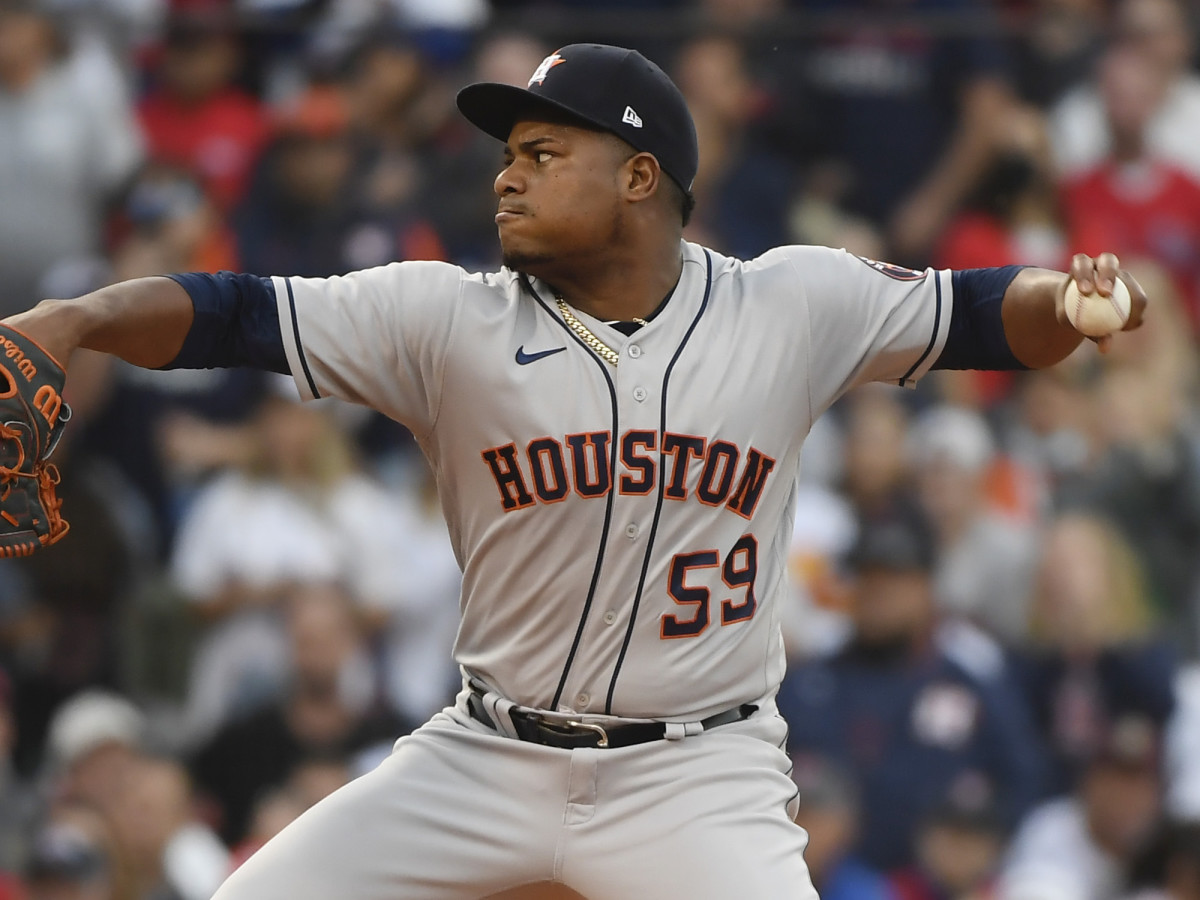Framber Valdez's Sinkers Push Boston to the Brink of Elimination

BOSTON – Framber Valdez began the game with a statement. He threw the Boston Red Sox 12 consecutive sinkers to start Game 5 of the American League Championship Series on Wednesday, after which he and the Astros were back in the dugout with a 1-2-3 inning in the books. Why open the game without even a whiff of mystery or deception?
“That’s the pitch he feels most comfortable throwing strikes,” says Houston catcher Martin Maldonado.
Valdez typically throws his sinker 92.5 mph. These sinkers were angrier. They were zipping along at 94, 95, even 96 mph. Better still, the sinker slithered away from the barrels of the Boston bats with late, darting movement.
Maldonado was so impressed by the opening dozen sinkers he asked the analytics managers of the Astros after the inning if the metrics matched what he was seeing behind the plate.
“And they said it was probably the best he had all year,” Maldonado says.

This has been the postseason that has devalued starting pitching. Starters are averaging four innings per start. Only three times in the first 52 starts did a pitcher throw 100 pitches. So, in this era, for Valdez to pitch so long and so well as to invoke the greatness of Bob Gibson was a major turning back of time. Relying heavily on his sinker, Valdez throttled Boston with eight innings of supreme old-school pitching. He allowed the Red Sox just three hits while getting 15 of his 24 outs on grounders.
Of the 91 postseason games played at Fenway, Valdez and Gibson, in the 1967 World Series, are the only visiting starters to go at least eight innings and allow three hits or less. Valdez is also the only starter this postseason to last eight innings.
“That’s as good as it gets with him,” Maldonado says. “That was his ‘A’ game.”
Valdez put the Astros on the doorstep of their third World Series among the past five almost by himself. A starting pitcher dominating a game? How quaint.
He did have some help, especially from Yordan Alvarez, who had a staggeringly impressive night against Boston starter Chris Sale. Three times Alvarez punished Sale’s four-seam fastball for hits, once for a homer, once for a double and once for a single. Alvarez is the game’s best left-on-left slugger. He has more RBI through his first 233 games (186) than any active player did. And what he did in Game 5 was his most astonishing accomplishment yet.
A left-handed hitter cranking out three hard hits off Sale is unheard of. The left-on-left homer? A rarity. Sale had allowed only one homer in his career with his four-seam fastball to a lefty—back in 2017 to Kevin Kiermaier.
Sign up to get the Five-Tool Newsletter in your inbox every day during the MLB playoffs.
Meanwhile, the Red Sox had trouble elevating Valdez’s pitches. The dozen sinkers in the first inning announced the rules of engagement: he was armed with a good sinker and he was going to attack with it. Valdez threw a few four-seamers and rolled in his curveball just often enough, especially with two strikes, but that sinker carried him deep into the Fenway night, lit by the arc lamps of the 109-year-old ballpark and a luminous full moon. This moon was known as a Hunter’s Moon. A Hunter’s Moon is one that follows a Harvest Moon, an ancient signal to hunt for the sustenance that will carry one through the winter. Hunting is a good way to describe how Valdez attacked the strike zone.
So good was Valdez with his sinker/curveball combo that at one point early in the game he asked Maldonado, “What about the changeup?”
“Wait,” Maldonado responded. “Maybe we’ll throw it later.”
Valdez threw one changeup all night.
“I felt like it was running,” Maldonado says, when asked why Valdez kept the pitch in his pocket. “So we stayed with the curveball and sinker. We didn’t need it.”
Valdez looked like a different pitcher from the guy in Game 1 who was knocked out in the third inning. He smiled on the mound and closed his eyes in the dugout between innings as if nodding off, the picture of contentment.
“Tranquilo,” Valdez says, putting a word to the calm he maintained.
Says Maldonado, “Today he was [calm]. That was one of the things he didn’t do the first game. I think he was amped up before the first game.
“That guy has been through a lot of stuff. A broken finger in spring training, people saying he would be out all year … here he is.”

Before his previous start, Valdez dove deep into scouting reports on the Red Sox to find weaknesses he might exploit. His homework on the opponent was exhaustive, which was out of the norm for Valdez.
“Usually, the meetings are all the same,” pitching coach Brent Strom says. “We might talk for about a minute 45 and then we just say, ‘Aw, just Framberize ‘em'—sinkers down and curveballs for swings and misses. His stuff is that good.”
You must go back nine years to find a pitcher who won an AL postseason game by going eight innings or more with five strikeouts or less (Justin Verlander in the 2012 ALCS). Watching Valdez pitch was like listening to vinyl: nostalgic, with a reminder of the sweetness of what we have been missing. No one sounded more impressed than Boston manager Alex Cora.
“I think their guy was amazing,” Cora said in the interview room. “He was throwing harder than usual. The ball was moving. We didn't hit the ball hard at all. I think we had two fly balls, if I'm not mistaken, and a home run, right? Credit to him. His sinker was unreal tonight. Unreal. You tip your hat to him and you move forward.”
Valdez was signed for just $10,000 in 2015 at age 21, which is five years past the age when the top prospects create bidding wars. The Astros found a gem out of the town of Palenque, Dominican Republic, the same town that produced Francisco Liriano and Ivan Nova, two other pitchers with outstanding breaking pitches.
Valdez did not record an out in the air until after he had worked through the Boston lineup two full times through. The first eight balls put in play against him were groundball outs. To watch Valdez continually force the Red Sox into pounding his pitches into the dirt, and then watching the veteran Houston infielders gobble them up with soft hands and textbook footwork, was to watch a gray-flanneled game that has long faded from view, especially in this postseason in which we see 12, 13, even 14 pitching changes.
There was rhythm and beauty to it, like ballet. It invoked the grace of Gibson on the mound. When Gibson pitched the other gem at Fenway by a visitor with no more than three hits allowed over at least eight innings, he did so in Game 7 of the 1967 World Series. On the eve of that start, Gibson went to the Jazz Workshop, a club on Boylston Street near Copley Square, to listen to his good friend, Les McCann, an innovative jazz pianist and vocalist. Gibson stayed a couple of hours.
Gibson would later say, “We danced in our seats.”
It’s easy to imagine the scene. McCann playing cool, funky jazz while Gibson, his Game 7 appointment with the Red Sox at Fenway only hours away, enjoying the night as the music washed over the room. Such was the vibe Valdez gave to ALCS Game 5. It was a vinyl kind of night at the Fens.
More MLB Coverage:
• Altuve's Mid-Game Tweak Sparks Houston's Series-Tying Rally
• The Rebirth of Cody Bellinger Resuscitates Los Angeles
• Carlos Correa's Seventh-Inning Homer Is a Masterpiece
• In Moving an Inch, Kiké Hernández Stands Among Giants
